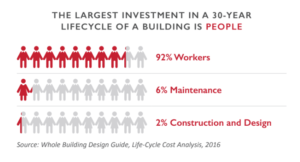Looking at a price tag for a workplace relocation or renovation can be scary: rent, space design, construction, movers, technology, furniture, swing space. It adds up, and when it does, the immediate response is to look for cost savings: Can we make workstations smaller to fit into a reduced footprint? Do we really need 10 meeting rooms or will 5 do? Do all the meeting rooms need to be outfitted with technology or just half of them? 
According to the Whole Building Design Guide, the largest investment in a 30-year lifecycle of a building is people (i.e., personnel costs) – 92%! Workplace change initiatives require large upfront investment; however, the more you invest in and engage with your people during the change process the less you have to invest in the long term on recruitment and retention efforts, morale boosters, and future space changes to accommodate special requests due to resistance. Here are four tips for prioritizing your people during a workplace change.
FOUR TIPS FOR PRIORITIZING YOUR PEOPLE
- Create a Sense of Ownership. Identifying areas for employee input gives employees a voice in the process and will build feelings of ownership and excitement about the space. Give staff an opportunity to engage with the decision-making process so they feel as invested in the space as you do. Host events to let employees test out furniture, vote on finishes or names of conference rooms, and experience the space design. Perhaps even include them in the upfront visioning about their ideal workplace.
- Communicate. Communicate. Communicate. Transparency is one of the greatest ways to gain trust from people. By creating an open line of communication with employees and stakeholders, you start to build trust in the change process and the future vision for the workplace. Establish a regular cadence of communication to provide insight into the project status and what to expect. Share outcomes from engagement events, surveys, and decision-making meetings to create a common understanding of the direction of the workplace change.
- Create Opportunities for Feedback. Providing regular opportunities for feedback from employees and stakeholders will provide you with an understanding of potential pitfalls and the “story” people are holding, and help you set expectations. By collecting regular feedback, your people feel heard and – in most cases – can live with the outcomes of the workplace change, even if it wasn’t 100% what they wanted.
- Make it Fun! Incorporate a little fun into the change process – both in engagement activities with employees and stakeholders and within the workplace planning team itself. Remember to acknowledge team, employee, and vendor contributions, and celebrate milestones and successes with reflections and acknowledgments. This will help maintain momentum, boost morale and excitement, and reduce change fatigue.
Thinking about engaging your staff around your workplace change? Drop me an email. We can help you navigate the workplace change and help improve how your people experience the change.
